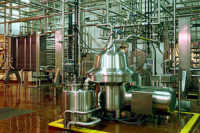In general, prior to the mid-1980s, the sanitation of non-product contact surfaces on the environment was not a high priority.
In general, prior to the mid-1980s, the sanitation of non-product contact surfaces on the environment was not a high priority. Bacteriological monitoring of non-product contact surfaces was rarely performed. These surfaces were thought to have little effect on the quality or safety of finished products. In 1985-86, the food and dairy industries were shaken to their core when it came to light that pathogens such as Listeria and Salmonella were capable of establishing residence in plant environments and eventually finding a way to contaminate product contact surfaces and finished products.
The discovery that pathogens seem to “grow legs” and move through the environment sparked a revolution in the dairy industry’s food-safety defenses. Since some pathogens are “mobile,” swabbing or testing of environmental surfaces was adopted as a standard practice for minimizing the potential for contamination of dairy products. This practice has now been taken up with the new Food and Drug Administration’s Food Safety Modernization Act (FSMA), signed by President Obama in early January. One of the many new provisions required of dairy plants will be a mandatory environmental sampling and testing program. The new FSMA program, expected to be enforced no later than mid-2012, will require test results be available to FDA investigators.
Effective environmental sampling programs require a plant manager to make a number of key decisions:
Sampling protocol. Decide kit selection, testing specifics and the number of samples to be tested.
Testing protocol. Decide whether to use an in-house or third-party laboratory and which pathogens (species or genera?) to target.
Follow-up action and responsibility. Swabbing and testing will not eliminate pathogens from the environment, but will tell you where they are hiding. A robust cleaning and sanitizing program is required for the control or elimination of pathogens from the plant environment.
The recommended environmental sampling and testing program requires the plant facility to be divided into three zones:
Zone 1. Areas in the facility that are very close to product contact surfaces, but not product contact surfaces, including under surface of filler bowl exteriors, filler piston exteriors, novelty mold surfaces, star wheels, in-line conveyor chains, etc.
Zone 2.Areas within close proximity to the finished product/packaging area, including control panels, phones, framework or sides of equipment.
Zone 3. Includes floors, floor drains, catwalks, underside of filling machines, wheels on dollies, forklifts, trash disposal areas, etc.
Once the zones have been categorized, it is recommended that at least 100 specific environmental sampling sites be established according to the potential for contamination of finished products with 50 in Zone 1, 30 in Zone 2 and 20 in Zone 3. Depending upon prior test results and the potential for product contamination, 10 to 30 sites should be swabbed and tested monthly. Use random numbers to select the sites to be tested. Remember: The primary objective is to find “hot spots” so they can be eliminated.
Follow-up. You must put in place a plan of action to deal with positive test results. This plan must involve a thorough understanding and application of basic sanitation procedures.
All dairy plants need to have a robust environmental sampling and testing program in place. The program should define the basic sampling and testing protocol, establish staff responsibilities and a plan for follow-up when positive results are indicated. If implemented effectively, it will serve as a necessary early-warning system that can reduce or eliminate microbiological contamination of ingredients, packaging and finished dairy products.
Henry E. Randolph is the founder of Randolph Associates Inc., which advises dairy processors about improving quality and operations.
Related Articles
Events
View AllSubmit An Event-
April 25, 2013 Food Plant of the Future: Global Food Safety Impact on Facilities
-
March 1, 2010 Food Plant of the Future: Advancing Food Safety through Sanitary Design
×
Get our new eMagazine delivered to your inbox every month.
Stay in the know on the latest dairy industry trends.
SUBSCRIBE TODAYCopyright ©2024. All Rights Reserved BNP Media.
Design, CMS, Hosting & Web Development :: ePublishing


